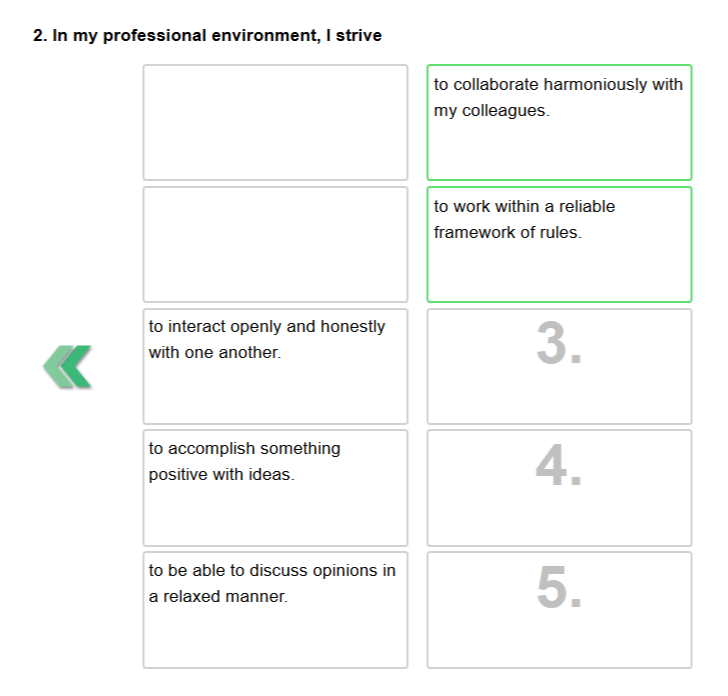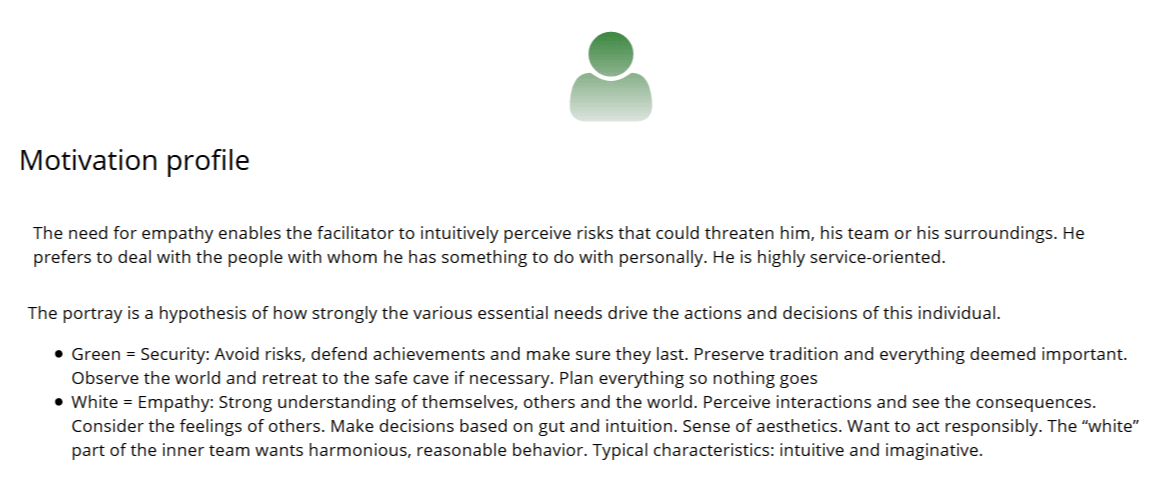Questionnaire
Integrate Questionnaire
The task of a questionnaire is to collect information from which certain characteristics can be inferred. The IPM questionnaires use either ranking methods, text analysis or a combination of both.
IPM uses an analysis generator for the texts of the questions and the assignment of items. This makes it quick and easy to adapt to customer requirements. 1 to 30 questions can be defined according to the ranking procedure or as text entries.
Each questionnaire type can be integrated into software environments. The call, for example by an HR or CRM application, is made as a "single sign-on" with the transfer of parameters such as the desired questionnaire version, the ID and optionally name, gender, contact type and language.
In a separate browser window or within a frame defined by the application, each question is displayed after the call. If not set otherwise, the analysis is performed immediately after the last question and the result is displayed.
As an alternative to this procedure, the questions can also be programmed on the application side. In this case, the software sends the user's input via web service for immediate analysis.
Ranking procedure
On the left side texts or pictures are displayed one below the other. The user has the task to move these items into the right fields, sorted according to his own preferences. For example:

Text questions
The user should answer open questions in writing for the potential analysis, or copy existing texts, such as job descriptions or e-mails, into the text field for external profiles.
For the self-profile, several tasks are set one after the other, such as:
 At least 50 characters must be entered or copied into the field before the
next question or result is called.
At least 50 characters must be entered or copied into the field before the
next question or result is called.
Foreign languages
Most questionnaires are available in German, French and English.
All languages that are supported by Google Translate can be used to enter text through text analysis.
Typically, German or English questions and hints are used to control text analysis. If translations are available, a French, Italian, Russian or other language user interface can also be agreed.
Browser window or frame - questionnaire and result display
The questionnaire is processed either in a new browser window or in a frame of the controlling software solution.
If the integration does not provide otherwise, the results are displayed to the user at the end of the questionnaire processing and a PDF document is offered for download.
Various formats are available for the presentation of the results, which can largely be adapted to customer requirements. Here is an example:

White label solutions and integration into other questionnaires
The questionnaires can also be designed and controlled on the pages of the software solution. This is useful, among other things, if different questions are to be combined with each other, as is useful, for example, in market research.
In this case, the parameters of the rankings (e.g. question 2, positions 3,4,5,1,2) are transferred via an API. IPM then answers with a type number and the analyzed values.
Interactive Advice System
In principle, the same procedures also apply to the IAS system. The call is made with the customer ID and the agent ID because various statistical usage reports are generated.
Usually, the IAS is part of a CRM system and is started when the data for a customer is called and closed again when processing is finished. Sometimes an icon in the CRM mask will also be used to start the IAS.
The IAS is almost always designed individually for a customer service project.
All input and output elements can be freely defined. Here is an example:
 The analysis is repeated with every click and a communication type is
calculated. The results are immediately displayed in this mask, so that the
agents are shown arguments and suggestions for objection handling that match
the course of the conversation.
The analysis is repeated with every click and a communication type is
calculated. The results are immediately displayed in this mask, so that the
agents are shown arguments and suggestions for objection handling that match
the course of the conversation.
The IAS Editor / Generator is used for the design of these masks, the required analytics and the control of the display (e.g. which button should be displayed or hidden in which situation with which effect?). Thus, adjustments, for example as a reaction to the feedback in the projects, can also be implemented on demand.